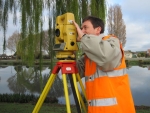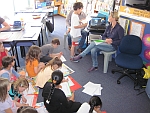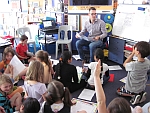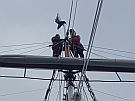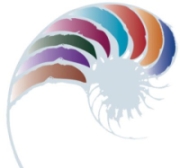
All LEARNZ field trips targeting primary and secondary schools are closely linked to the New Zealand curriculum, in particular health and physical education, science and social studies. They can also be used by other subject teachers.
Key concepts
Adventure, Auckland, expedition, explorers, goal setting, hauora, heritage, identity, inspiration, islands, leadership, managing resources, Māori, marine environment, migration, ocean currents, oceans, Outdoor Education, outdoor pursuits, Pacific Ocean, people and the environment, people in the past, personal health, resilience, risk management, traditions, voyaging, weather, wind.
The New Zealand Curriculum - NZC
Key Competencies
LEARNZ virtual field trips contribute to the development of all five key competencies:
| Key Competencies | Examples of Related Field Trip Components |
| Thinking | Constructing questions to put to experts during web conferences. |
| Using language, symbols and texts | Interpreting and making meaning of a variety of language and symbols in the Background Pages and throughout the web site. |
| Managing self | Numerous content-related Activities provide students with chances to engage with the material and create their own interpretation of the content. |
| Relating to others | Videos connect students with a range of expert opinions. Students listen actively when seeking answers to video questions. |
| Participating and contributing | LEARNZ Virtual Field Trips are an ideal medium for group-based topic inquiry. They also enable students to transfer new learning into the context of their own communities where they are encouraged to take action. |
(See page 12-13 NZC 2007)
Values
The Spirit of Adventure field trip encourages, models and explores these values:
- innovation, inquiry and curiosity
- ecological sustainability
- community and participation
(see page 10 NZC 2007).
E-learning and pedagogy
The Spirit of Adventure field trip directly involves learning that is supported by information and communication technology (ICT).
In particular, the trip will:
- Assist the making of connections by enabling students to enter and explore new learning environments, overcoming barriers of distance and time.
- Facilitate shared learning by enabling students to join or create communities of learners that extend well beyond the classroom.
- Enhance opportunities to learn by offering students virtual experiences and tools that save them time, allowing them to take their learning further (Page 36 NZC 2007).
Health and Physical Education
| Strand | Achievement Aims | Related Background Pages |
|
Personal health and physical development - A
|
A3 Safety management L2: Identify risk and use safe practices in a range of contexts. L3: Identify risks and their causes and describe safe practices to manage these. L4: Access and use information to make and action safe choices in a range of contexts. L5: Investigate and practise safety procedures and strategies to manage risk situations. |
|
|
Relationships with other people - C
|
C1 Relationships L2: Identify and demonstrate ways of maintaining and enhancing relationships between individuals and within groups. L3: Identify and compare ways of establishing relationships and managing changing relationships. L4: Identify the effects of changing situations, roles, and responsibilities on relationships and describe appropriate responses. L5: Identify issues associated with relationships and describe options to achieve positive outcomes. |
|
|
Healthy communities and environments - D
|
D1 Societal attitudes and values L2: Explore how people’s attitudes, values, and actions contribute to healthy physical and social environments. L3: Identify how health care and physical activity practices are influenced by community and environmental factors. L4: Investigate and describe lifestyle factors and media influences that contribute to the well-being of people in New Zealand. L5: Investigate societal influences on the well-being of student communities. |
|
Social Science
| Strand | Achievement Aims | Background Pages |
|
Identity, Culture and Organisation
Continuity and Change
Place and Environment
|
Level 2: Understand how cultural practices reflect and express people’s customs, traditions, and values.
Level 3: Understand how early Polynesian and British migrations to New Zealand have continuing significance for tangata whenua and communities.
Level 4: Understand how exploration and innovation create opportunities and challenges for people, places, and environments.
Level 5: Understand how the ideas and actions of people in the past have had a significant impact on people’s lives. |
Technology
| Strand | Achievement Aims | Background Pages |
|
Nature of Technology
|
Nature of Technology
|
|
English
The selected processes and strategies indicators used in the table below are from Level three of the NZC, but aim to cover indicators from levels two to four.
| Strand | Processes and Strategies Indicators | Example of Related Field Trip Component |
|
Speaking, Writing and Presenting
|
|
|
|
Listening, Reading and Viewing
|
|
|







